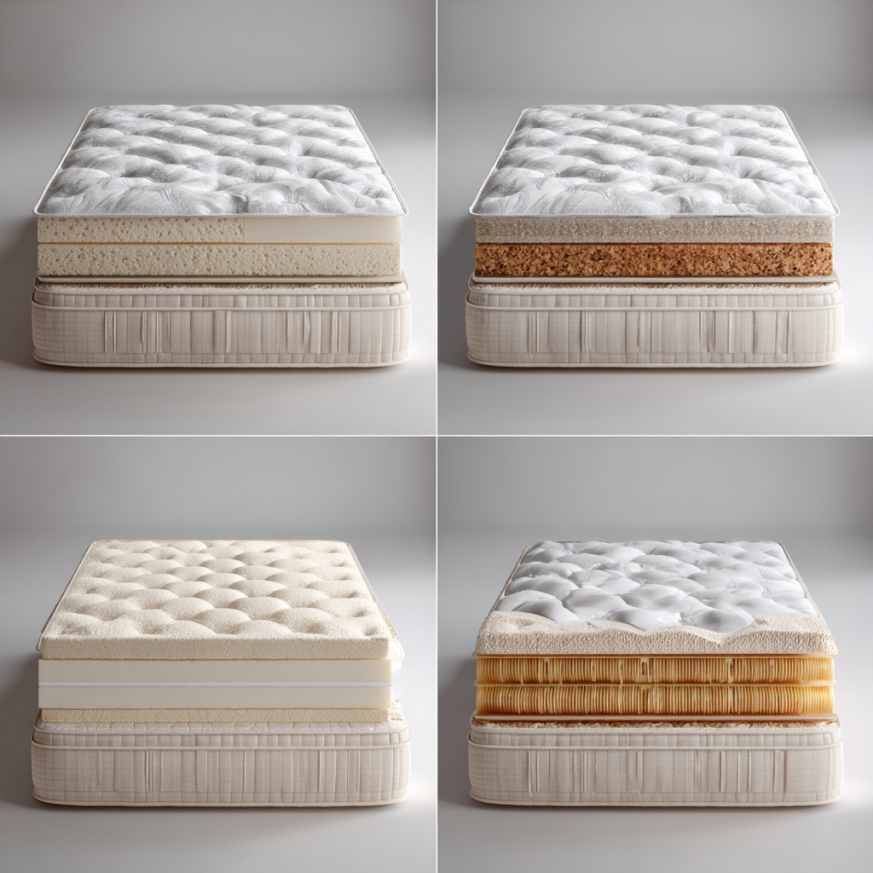Mattress Buying Mistakes: Top 10 to Avoid for Better Sleep
Avoid these 10 common mattress buying mistakes to save money and improve comfort—learn which ones to skip for better sleep quality.
Key Takeaways on Mattress Buying Mistakes
- Avoid focusing solely on price—prioritize long-term value.
- Choose a mattress that suits your sleep position and preferences.
- Always test the mattress either in-store or during a trial period.
- Don’t fall for marketing gimmicks—research materials and reviews.
- Consider your partner’s needs and mattress firmness levels.
- Read the fine print for warranty and return policies.
1. Prioritizing Value Over Price – Common Mattress Buying Mistakes
While it’s tempting to choose a mattress based solely on price, focusing on value is more important. A mattress should offer the right balance of cost and quality, ensuring it supports your body properly and lasts for years. Opting for a low-cost option might lead to discomfort and a shorter lifespan, while a well-researched purchase can provide lasting comfort and support. Remember, the cheapest option today could end up costing more in the long run due to frequent replacements and potential health issues.
Moreover, high-quality mattresses often use premium materials that are not only more durable but also offer better sleep ergonomics. Choosing a mattress that supports spinal alignment and pressure relief can prevent long-term health issues such as back pain or restless sleep.
2. Ignoring Your Sleep Position – Mattress Buying Mistakes to Avoid
Your sleep position significantly influences the type of mattress you need. Side sleepers often benefit from softer mattresses that cushion pressure points like the shoulders and hips. Back sleepers require firmer options to maintain spinal alignment, while stomach sleepers need medium-firm mattresses to prevent their body from sinking too deeply. Choosing the right mattress for your sleep position can prevent discomfort and promote better sleep.
Understanding your dominant sleep position can help narrow down your choices quickly. If you’re a combination sleeper, consider hybrid mattresses that balance responsiveness and support across various positions. A mattress that adapts well to movement ensures uninterrupted rest even as you shift positions overnight.

3. Not Testing the Mattress Properly – Overlooked Mattress Buying Mistakes
Testing a mattress in-store or during a trial period is crucial. Spend sufficient time lying on the mattress in your usual sleeping position to assess comfort and support. If purchasing online, look for companies that offer trial periods, allowing you to test the mattress at home and ensure it meets your needs.
Even a few minutes of testing in-store can offer insights into a mattress’s feel, but an extended trial at home under real sleep conditions provides the most reliable judgment. Consider brands with generous return policies and transparent customer support.

4. Falling for Marketing Gimmicks – Misleading Mattress Buying Mistakes
Mattress marketing often includes terms like “luxury foam” or “cooling technology,” but not all claims are scientifically proven. Instead of relying on these terms, research the materials, certifications, and customer reviews to ensure the mattress delivers on its promises. Certifications like CertiPUR-US or OEKO-TEX can also provide assurance about the product’s quality and safety.
Don’t be swayed by flashy ads or influencer recommendations alone. Look for independent product reviews and verified customer feedback to form an objective view of the mattress’s real-world performance.
5. Overlooking Your Partner’s Needs – Shared Mattress Buying Mistakes
If you share a bed, it’s essential to consider both partners’ preferences. Look for mattresses that offer features like motion isolation or dual firmness to cater to different needs. Testing mattresses together can help you find one that works for both, ensuring restful sleep for both partners.
Ignoring your partner’s sleep needs can result in discomfort or frustration. For example, a light sleeper may benefit from materials that minimize motion transfer, while someone else might need firmer support. Communication is key during the buying process.
6. Skipping Research on Mattress Materials – Informational Mattress Buying Mistakes
Understanding the various types of mattresses can greatly enhance your satisfaction. Memory foam is known for its pressure relief, latex for its durability and eco-friendliness, innerspring for its bounce and airflow, and hybrids for their versatility. Researching these options helps you choose a mattress that aligns with your preferences and lifestyle.
Each material offers a distinct feel and performance level. Natural latex, for example, provides a resilient bounce and is often hypoallergenic. Hybrid mattresses combine benefits, making them a solid choice for couples or those with changing sleep needs.

7. Misunderstanding Firmness Levels – Misjudged Mattress Buying Mistakes
Firmness is subjective and can vary based on body weight and personal preference. A mattress labeled “medium-firm” may feel different depending on individual factors. Reading product specifications and reviews, along with taking advantage of trial periods, can help ensure the firmness matches your expectations.
Don’t assume that a single firmness rating fits all. Consider mattresses that offer firmness customization or dual comfort zones. Test several models and consult firmness scales to ensure alignment with your specific sleep requirements.
8. Skipping the Fine Print – Avoidable Mattress Buying Mistakes
Pay attention to the warranty, return policy, and trial period when purchasing a mattress. A comprehensive warranty and generous trial period offer peace of mind, allowing you to return the mattress if it doesn’t meet your expectations. Look for policies that provide at least a 10-year warranty and a 100-night trial.
Understanding these terms ensures you’re protected against defects or dissatisfaction. Watch out for hidden costs like restocking fees or return shipping that could affect your overall investment.
9. Assuming More Money Means Better Quality – Expensive Mattress Buying Mistakes
A higher price tag doesn’t always equate to better quality. While premium materials can justify a higher cost, it’s important to research customer feedback and compare features. Many mid-range mattresses offer excellent comfort and durability, rivaling more expensive options.
Set a realistic budget and assess what features matter most. You might find hidden gems among lesser-known brands offering superior comfort and longevity at a fraction of the cost of premium competitors.

10. Rushing the Decision – Last-Minute Mattress Buying Mistakes
Take your time when selecting a mattress. Rushing can lead to choices that don’t fully meet your needs. Explore different options, ask questions, and consider all aspects before making a decision. Your sleep is crucial for overall well-being, so treat the process as an important investment in your health.
Slow decision-making may delay your purchase slightly, but it can lead to greater long-term satisfaction and well-being. Take notes, read comparisons, and consult sleep experts if needed.
Mattress Buying Mistakes Bonus Tip: Consider Sleep Accessories
In addition to selecting the right mattress, think about complementary sleep accessories like pillows, mattress toppers, and adjustable bed frames. These items can enhance comfort and extend your mattress’s lifespan. For instance, a mattress protector can shield against stains and wear, keeping your mattress in excellent condition.
Sleep accessories are more than add-ons—they’re essential for sleep optimization. Cooling pillows, weighted blankets, and ergonomic frames can elevate sleep quality even further, helping you wake up refreshed and energized.
FAQ
- What is the most common mattress buying mistake?
- Choosing based on price alone without considering comfort and durability.
- How can I choose the right mattress for my sleep position?
- Side sleepers need softer mattresses, while back and stomach sleepers need firmer options for support.
- Is a higher-priced mattress always better?
- Not necessarily—mid-range mattresses can offer similar comfort and durability if researched properly.
Conclusion – Avoid Mattress Buying Mistakes for Better Sleep
By avoiding these common mattress buying mistakes, you can make a more informed decision that supports your health and enhances your sleep quality. A careful, research-based approach helps you invest wisely and enjoy long-term sleep benefits.
For more detailed guides and tips on achieving the best sleep, visit Cozy Bed Quarters.
rs.




